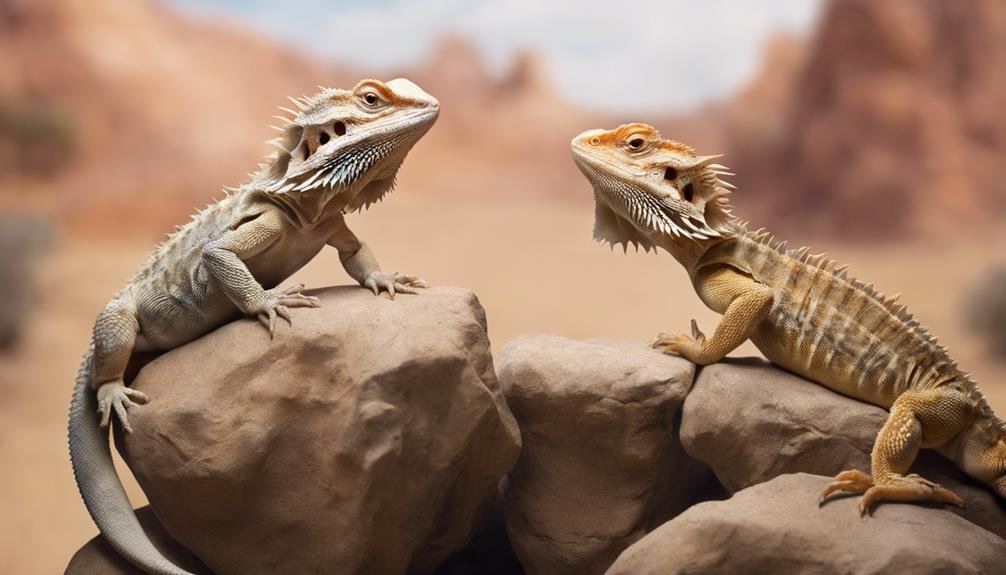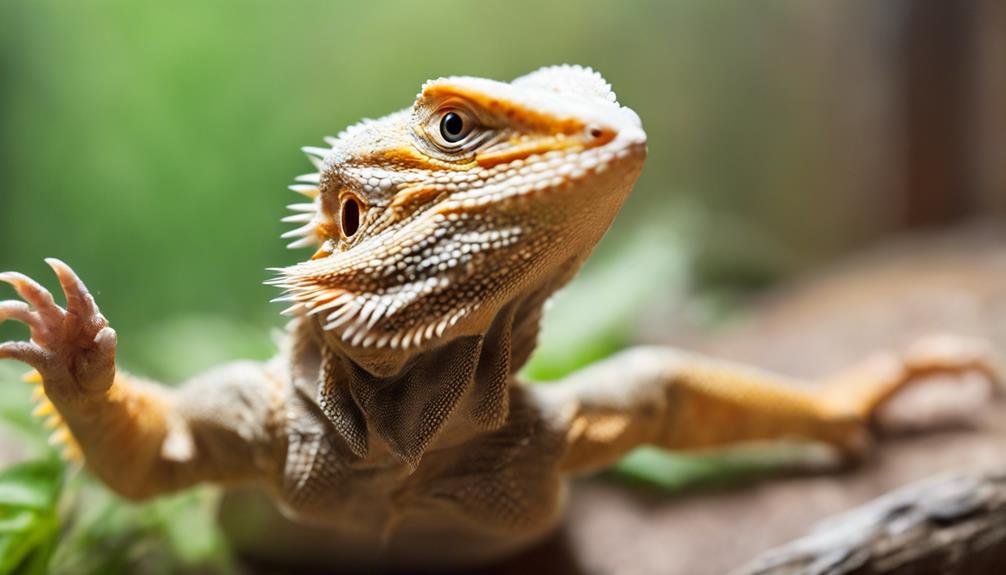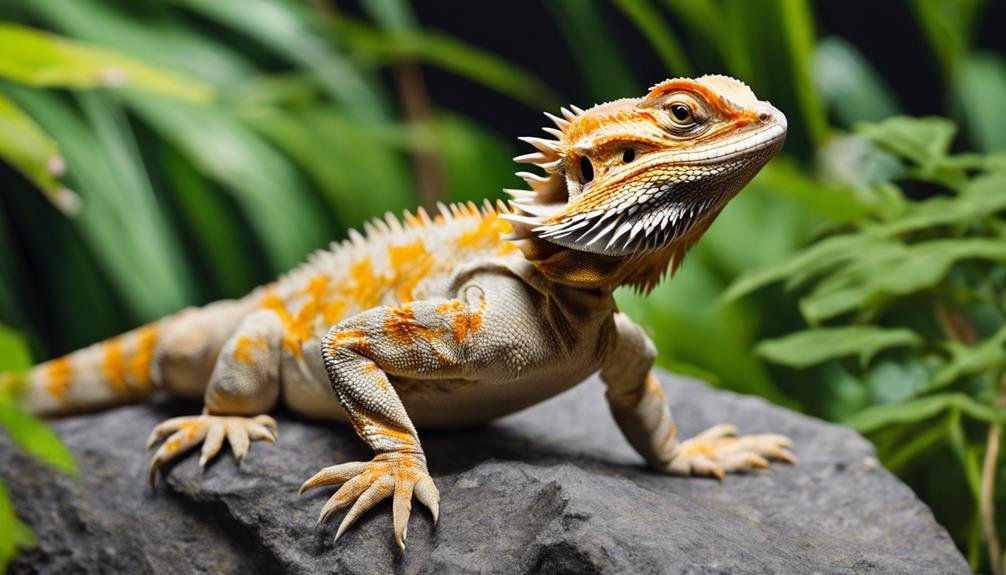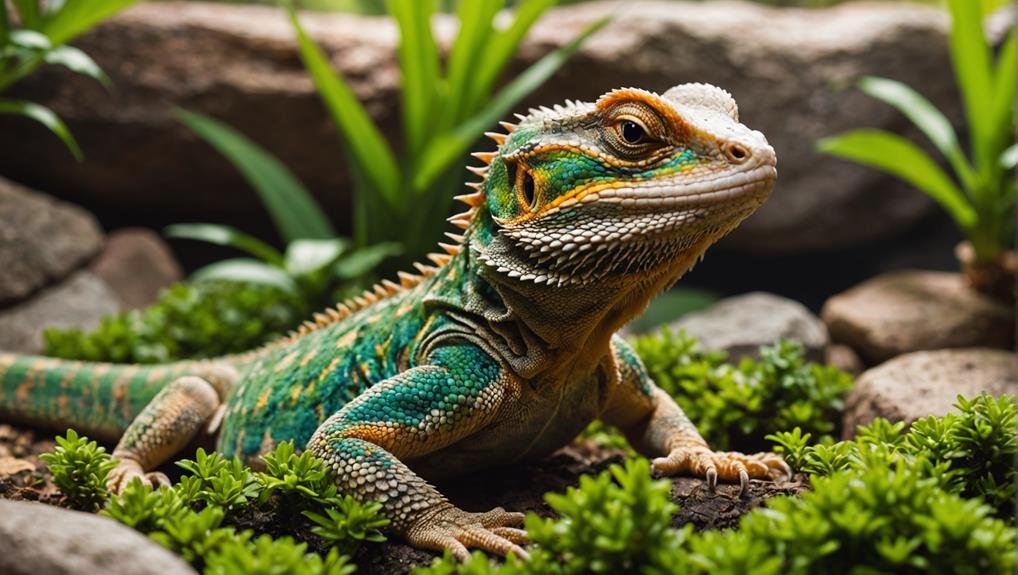You might have noticed your bearded dragon waving its arms and wondered about the meaning behind this peculiar behavior. This gesture isn’t random; it’s a form of communication that plays a significant role in their social interactions. Often seen in younger dragons, arm waving serves as a submissive signal towards larger or more dominant animals, helping to avoid conflicts and maintain group harmony. However, this behavior isn’t limited to interactions with other dragons—sometimes, they even wave at humans or objects. Are you curious about what prompts this intriguing display and its various implications?
Key Takeaways
- Bearded dragons wave as a sign of submission to avoid conflicts with larger or dominant dragons.
- Arm waving acknowledges the presence of other animals or potential threats in their environment.
- Juvenile dragons use arm waving to establish their place in the social hierarchy.
- This behavior is a natural communication style indicating non-aggressive intent.
- Environmental stressors like poor lighting or lack of enrichment can trigger arm waving.
Understanding Arm Waving


Understanding arm waving in bearded dragons is crucial for any owner wanting to interpret their pet’s behavior accurately. When your bearded dragon waves its arm, it’s often a sign of submission. This gesture typically occurs in young beardies who use it to acknowledge the presence of larger animals or potential threats. By waving, they say, “I’m not a threat; please don’t hurt me.”
You might notice your dragon waving at objects that aren’t animals. This behavior shows their instincts and communication style, even if the object is a harmless decoration in their enclosure. Owners sometimes mistake arm waving as a friendly greeting, but it’s more about your dragon’s way of showing submission and ensuring its safety.
Due to their smaller size and frequent social interactions, young bearded dragons are particularly prone to arm waving. They use this gesture to navigate their world and communicate with other dragons or creatures they perceive as dominant. Recognizing arm waving as a sign of submission rather than a simple hello can help you better understand your bearded dragon’s needs and feelings, ensuring a happier, more secure environment for your pet.
Submission to Larger Dragons
When you see a bearded dragon waving, it signals non-aggressive intent toward larger dragons or perceived threats. This behavior helps your pet avoid potential conflicts and maintain harmony in its environment.
Younger dragons, in particular, use this gesture to show respect and submission to dominant dragons.
Signaling Non-Aggressive Intent
Bearded dragons often wave to signal non-aggressive intent, especially toward larger dragons or perceived threats. When you observe this arm waving, it’s a clear sign that your bearded dragon is trying to communicate that it means no harm. This gesture is common in the dragon community to show submission and avoid confrontation.
When a bearded dragon raises one of its front legs and waves it in a circular motion, it’s saying, “I’m not a threat.” This behavior is particularly noticeable in younger dragons, still figuring out their place in the social hierarchy. They may wave more frequently as they navigate interactions with larger dragons and unfamiliar environments.
Understanding this arm-waving is vital for interpreting your bearded dragon’s behavior. It’s their way of communicating peace and deference to other dragons and anything they perceive as potentially threatening.
Avoiding Potential Conflicts
While signaling non-aggressive intent is a key aspect of arm waving, avoiding potential conflicts with larger dragons is another significant reason behind this behavior. When a bearded dragon waves, it often shows a sign of submission to more dominant or larger dragons around it. This gesture helps convey that it poses no threat and wishes to avoid any aggressive interactions.
Imagine you’re a young, smaller bearded dragon in an environment with bigger, more dominant beardies. Waving your arm becomes a critical survival tactic. By doing this, you’re essentially communicating that you respect the social hierarchy and want to maintain harmony.
This submissive behavior is especially common among younger dragons, who are more vulnerable due to their size.
Maintaining peaceful relationships is vital for bearded dragons to thrive in the wild or in captivity. Arm waving as a sign of submission prevents potential conflicts that could lead to injuries or stress.
Acknowledgment of Presence


A key reason bearded dragons wave is to acknowledge the presence of others, whether they’re other dragons, humans, or potential threats. This waving behavior acts as a form of communication, showing that they’re aware and acknowledging what’s around them. It’s fascinating how a simple wave can convey so much information.
When you see a bearded dragon waving, it’s often a friendly gesture, especially towards humans. They’re letting you know they see you and understand your presence. Sometimes, it can also signal submission to a larger or more dominant dragon, indicating they don’t want to challenge or fight.
Younger beardies tend to wave more frequently than adults. Their smaller size makes them more cautious, and they’re more likely to use waving to acknowledge the presence of potential threats or larger animals.
Here are three reasons why a bearded dragon might wave:
- Friendly acknowledgment: Towards humans or other dragons.
- Submission: Signaling to larger or more dominant beardies.
- Mistaken identity: When they think an object is a potential threat.
Interaction With Humans
Recognizing the varied reasons behind a bearded dragon’s wave helps us understand their unique communication methods. When your bearded dragon waves its arm, it’s often a friendly gesture towards you. This behavior allows them to acknowledge your presence and show that they recognize you as a non-threatening part of their environment.
By waving back at your dragon, you’re responding positively to their attempt at interaction, which can strengthen the bond between you and your pet.
Understanding your dragon’s arm waving is vital for building a trusting relationship. Bearded dragons use this gesture to communicate various feelings, including acknowledgment and friendliness. It’s important to respect these cues and respond appropriately.
When you see your bearded dragon waving, take a moment to wave back or talk to them softly, reinforcing the positive interaction.
Awareness of their arm-waving behavior will make your dragon feel more secure and understood. It’s these small, consistent interactions that help create a deeper connection. Remember, your bearded dragon’s arm wave is more than just a quirky habit; it’s a meaningful way they choose to communicate with you.
Juvenile Behavior


When observing juvenile bearded dragons, you’ll often see them wave their arms. This behavior usually signifies submission to larger or older dragons and helps them communicate within their social hierarchy. Young dragons can avoid aggression and establish their place without conflict by waving.
Submission to Adults
In the social world of bearded dragons, juvenile beardies often wave their arms as a distinct sign of submission to the larger, more dominant adults. This behavior is vital for young dragons to demonstrate respect and avoid confrontations. By waving, juvenile beardies instinctively communicate their lower status in the social hierarchy, reducing the risk of aggressive interactions.
As a bearded dragon owner, you might notice your young dragons frequently waving their arms. This is a natural way for them to navigate their social dynamics and establish their place among other dragons. Arm-waving helps these juveniles stay safe and evade potential threats from adults.
Here are three key reasons why juvenile bearded dragons wave:
- Submission to larger dragons: Waving is a clear sign of respect and acknowledgment of the dominance of adult dragons.
- Avoiding conflicts: By showing submission, young dragons minimize the chances of aggressive encounters.
- Social structure: Frequent waving helps juveniles understand and establish their place within the social hierarchy.
This behavior is fundamental to their communication and ensures a smoother interaction with older, more dominant dragons. Understanding this can help you better interpret your bearded dragon’s actions and maintain a harmonious environment.
Territorial Communication
Territorial communication is another fascinating aspect of juvenile bearded dragon behavior. You’ll notice that young dragons frequently engage in arm-waving, which serves multiple purposes within their social structure.
When juveniles wave their arms, they often signal submission to older or larger dragons. This gesture helps them avoid conflicts by clearly communicating that they’re not a threat.
Arm-waving isn’t just about submission, though. Juvenile bearded dragons use this behavior to establish social hierarchies and boundaries within their community. By waving, they assert their presence and stake out their territory, making it clear to others where their boundaries lie.
This form of communication is vital for maintaining peace and order among the group.
You might also observe that juveniles use arm-waving to signal their location or intentions to other dragons. This non-verbal communication helps them navigate their social environment more effectively, ensuring they don’t inadvertently infringe on another dragon’s space.
Avoiding Aggression
Although juvenile bearded dragons are naturally curious and social creatures, they must also navigate the complexities of their social hierarchy. To avoid aggression from older or larger dragons, these young beardies use arm-waving as a crucial form of communication. This behavior signals submission and respect, helping to prevent confrontations and maintain peace within their group.
Arm-waving in juveniles is a clear way for them to communicate non-aggressive intentions. Lifting and waving their arms, they say, “I’m not a threat.” This submissive gesture is essential in a social setting where dominance and hierarchy play significant roles. Understanding why juveniles wave their arms can give you deeper insights into their social interactions and behavior.
Here are three key reasons why juvenile bearded dragons wave their arms:
- Submission: Arm-waving shows respect to older or larger dragons, indicating that the juvenile acknowledges their dominance.
- Peacekeeping: This behavior helps prevent aggressive encounters, ensuring a more harmonious group dynamic.
- Communication: It’s a clear, non-verbal way to express their non-threatening intentions, crucial for peaceful cohabitation.
Response to Objects
Observing bearded dragons wave at objects can be both intriguing and puzzling. You’ve probably noticed your dragon lifting its arm slowly, deliberately, almost like it’s saying hello. But why do they do this? One reason is that bearded dragons might wave at objects they mistake for threats or potential prey. It can trigger this response when they see something moving, like a toy or a shiny surface.
This waving isn’t just random; it’s a reaction to visual stimuli or movements in their environment. Younger beardies, in particular, are more prone to this behavior as they’re still learning about their surroundings. They’re trying to figure out what’s safe and what’s not. By waving, they communicate their awareness and alertness to whatever has caught their eye.
When your dragon waves at objects, it’s essentially stating, “I see you.” This helps them feel more secure by acknowledging the presence of potential threats or interesting targets.
Environmental Triggers


Environmental triggers play a significant role in why bearded dragons wave their arms. If your bearded dragon is arm-waving, it might be due to changes in temperature or stress levels or even as a way to seek social interaction. Shifts in the environment can cause your pet to feel threatened or the need to mark its territory. This response can often be accompanied by head bobbing, another form of communication in these reptiles.
Several environmental factors can lead to increased arm-waving:
- Territorial Disputes: If your bearded dragon perceives another animal or their reflection as a threat, you might notice more arm waving.
- Inadequate Lighting: Incorrect UVB lighting or lack of proper basking spots can stress your pet, resulting in more frequent arm waving.
- Lack of Enrichment: A dull environment without enough stimulation can lead to stress, prompting your bearded dragon to wave its arms as a cry for attention.
Poor husbandry practices, such as incorrect humidity levels or insufficient basking spots, can exacerbate these behaviors. Understanding these environmental triggers can create a more comfortable and stimulating habitat, reducing your bearded dragon’s need to wave its arms.
Social Hierarchy
Understanding the environmental triggers is just one part of why bearded dragons wave. Another pivotal aspect is their social hierarchy. Bearded dragons use arm-waving in the wild and captivity to communicate and show submission within their social structure.
When a lower-ranking dragon encounters a dominant one, it often waves its arm to signal that it acknowledges the other’s superiority. This gesture helps avoid unnecessary aggression and establishes a clear pecking order among the group.
Dominant males typically assert their status through head bobbing and territorial behaviors, making it crucial for subordinate dragons to display submissive behaviors like arm-waving. By doing so, they communicate their non-threatening intent and reduce the risk of conflict.
This behavior is essential for maintaining harmony within a group, whether in their natural habitat or a shared enclosure.
Mating Signals


Regarding mating signals, female bearded dragons use arm-waving to indicate they’re ready to mate. This form of communication is often accompanied by slow head-bobbing, creating a clear message for potential mates. The arm-waving gesture from females serves as a pivotal sinister breeding behavior, ensuring that males understand their intentions.
Males, on the other hand, have different gestures for their mating signals. They tend to circle the females and twitch their tails to show interest. This difference in behavior helps both sexes communicate effectively during the breeding season. It’s worth noting that males also wave, but this is usually a submissive gesture towards dominant males and not related to mating.
To summarize the mating signals in bearded dragons, consider these essential points:
- Female Gestures: Arm-waving and slow head-bobbing.
- Male Gestures: Circling and tail-twitching.
- Submissive Waving: Males wave to dominant males, not for mating.
Conclusion
In understanding why bearded dragons wave, you’ll see it’s a multifaceted behavior. They’re not just submissive to larger dragons but also acknowledging their presence and avoiding conflicts. This waving can extend to interactions with humans and even responses to objects or environmental triggers. Importantly, juveniles wave more frequently as they establish their place in the social hierarchy. By recognizing these signals, you can foster positive interactions and make sure your bearded dragon feels secure and understood.
FAQs
1. What Does It Mean if My Bearded Dragon Is Waving?
If your bearded dragon is waving, it’s displaying waving behavior as a form of communication. Depending on its age and social dynamics, it might be showing submission, respect, or receptiveness to mating.
2. Why Do Lizards Wave Their Arms?
Lizard communication often involves arm waving. When you see a lizard wave, it’s usually signaling submission or acknowledging another lizard or human. This non-verbal cue helps them navigate social interactions without aggression.
3. Why Is My Bearded Dragon Surfing?
Your bearded dragon’s surfing behavior might indicate stress, territorial instincts, or a need for attention. Inadequate tank size, improper temperature gradients, or lack of enrichment can trigger this wave behavior. To reduce surfing, provide a spacious, enriched habitat.
4. Why Do Bearded Dragons Sway Back and Forth?
Your bearded dragon’s swaying behavior helps it regulate body temperature and can indicate stress or discomfort. Monitor this activity to verify that it is comfortable and that its environment is properly maintained for its well-being.

